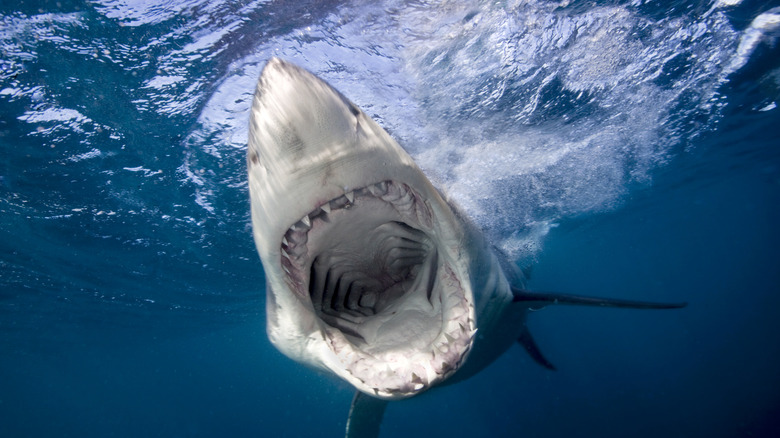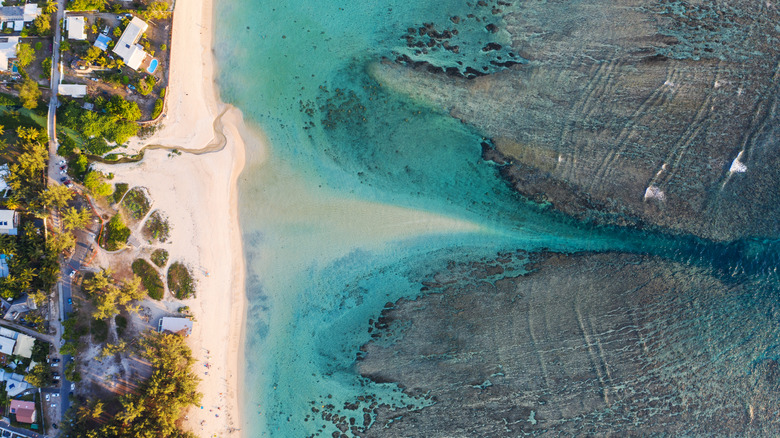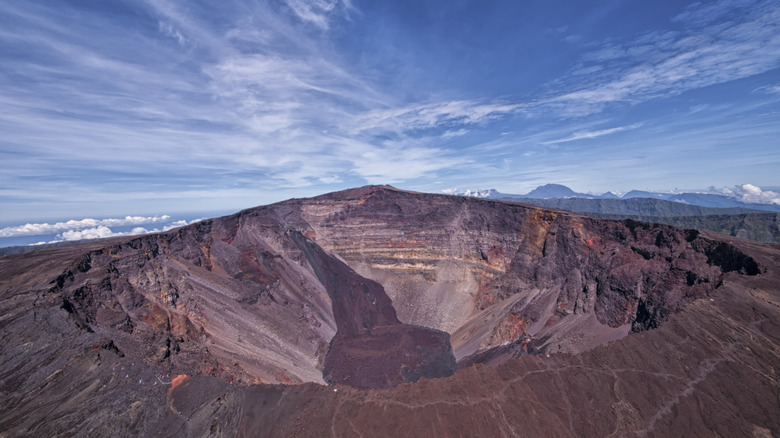The Breathtaking French Island That Is A Hot Spot For Dangerous Sharks
Anyone who's been to the beach knows the importance of water safety. While the sand and surf can be fun and relaxing, it's important to remember that the water is also home to thousands of creatures –– and some of them can be a threat to humans if we get too close. Even though the likelihood of a shark attack is rare, it's better to be safe when you're in the ocean. There are many dangerous, shark-infested beaches around the world, but issues with Réunion Island's shark attacks mean that many visitors can't enjoy the water on the beach, except in specific areas. The amount of attacks, as well as the ratio of fatal attacks, means that there are strict rules about where you can and can't swim.
Réunion Island is a tiny island controlled by France in the Indian Ocean off the eastern side of Africa. The small island is a little less than 500 miles from Madagascar and about 140 miles from the island of Mauritius. Despite the slightly dangerous waters, the island is full of colorful tropical forests, beautiful beaches, and fascinating volcanic areas. One of the main ways to reach Réunion Island is by flying through France, which has direct flights from Paris or Marseilles. You can opt to go through Johannesburg, Madagascar, Rodrigues, the Comoros, Mayotte, or Mauritius. Once you're on the island, it is best to rent a car and drive to the beaches and major attractions.
Swimming is banned in certain places on Réunion Island
Between 2012 and 2021, Réunion Island recorded 19 shark attacks, eight of which were fatal, according to the International Shark Attack File (via the Florida Museum). While that might not seem like a lot, there were 761 attacks worldwide in that time frame, only 60 of which were fatal, meaning that Réunion Island is home to 2.5% of attacks overall and 13% of all fatal attacks. For this reason, the island banned swimming in many areas in 2013. Certain things can actually attract sharks when you're snorkeling or swimming, such as bright colors and water temperature, but Réunion Island is more synonymous with shark attacks because it's in the middle of a very active area for sharks between South Africa and Australia.
But that doesn't mean you can't go swimming or snorkeling anywhere on Réunion Island. Water sports and swimming are not allowed within 300 meters (or about 984 feet) of the coastline, but the island has lagoons that are protected by either coral reefs or nets, as well as some being staffed with lifeguards. Among some of the more popular beaches that have nets are Black Rocks Beach, which is comprised of mostly pristine, white sand and a natural swimming pool, and Boucan Canot Beach, which has a net for safety. Hermitage Beach is great for snorkeling, but swimmers must keep to a designated area. Boucan Canot Beach is the closest beach to the town of Saint-Paul and has souvenir shops and plenty of places to eat. There are also lagoon beaches like Saint-Leu, Saint-Pierre, and La Saline-les-Bains. Additionally, visitors should check out the black sand Etang Salé beach, which has a water amusement park.
Other things to do that don't involve swimming on Réunion Island
There are plenty of other things to do on Réunion Island aside from swimming. Kélonia Aquarium in Saint-Leu is the perfect (and safest) place to see sea turtles in their habitat. If you'd like to visit one of the most active volcanoes on the planet, you can take a guided hike to the Piton de la Fournaise volcano. Or, hike to the Piton des Neiges, which is a dormant volcano that is also the highest on the island –– high enough that it's actually capped with snow. There are several gardens with hundreds of different kinds of plants like Domaine Du Cafe Grille (the Grilled Coffee Estate) botanical garden in Saint-Pierre, which has dozens of cinnamon trees, orchids, jasmine and bamboo growing on its grounds. Jardin des Parfums et des Epices (the Garden of Perfumes and Spices) in Saint-Philippe is also a great place to discover over 1,500 plants that are specifically used for spices, perfumes, medicines, and more.
If you're a history and culture lover, check out the Maison Folio, a 19th-century house and museum in Salazie dedicated to Creole life and history. Réunion Island is also incredibly diverse with communities from Africa, India, Europe, China, and Madagascar. The colorful Temple Tamoul Narassingua Perournal in Saint-Pierre is a Hindu temple offering guided tours of the site, decorated with figures and designs of every color in the rainbow. And if you're looking to explore outside of Réunion Island, you can easily hop on a plane to nearby Madagascar, the only spot in the world where you can see lemurs in the wild.


